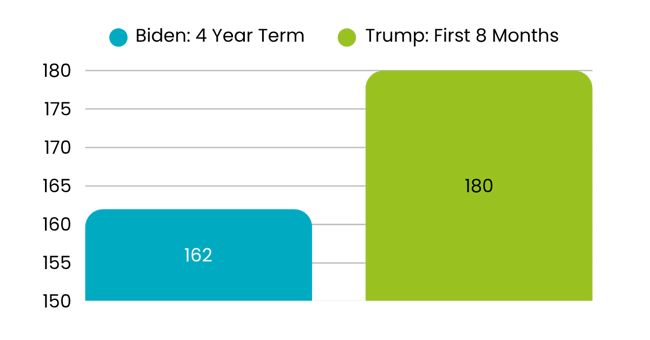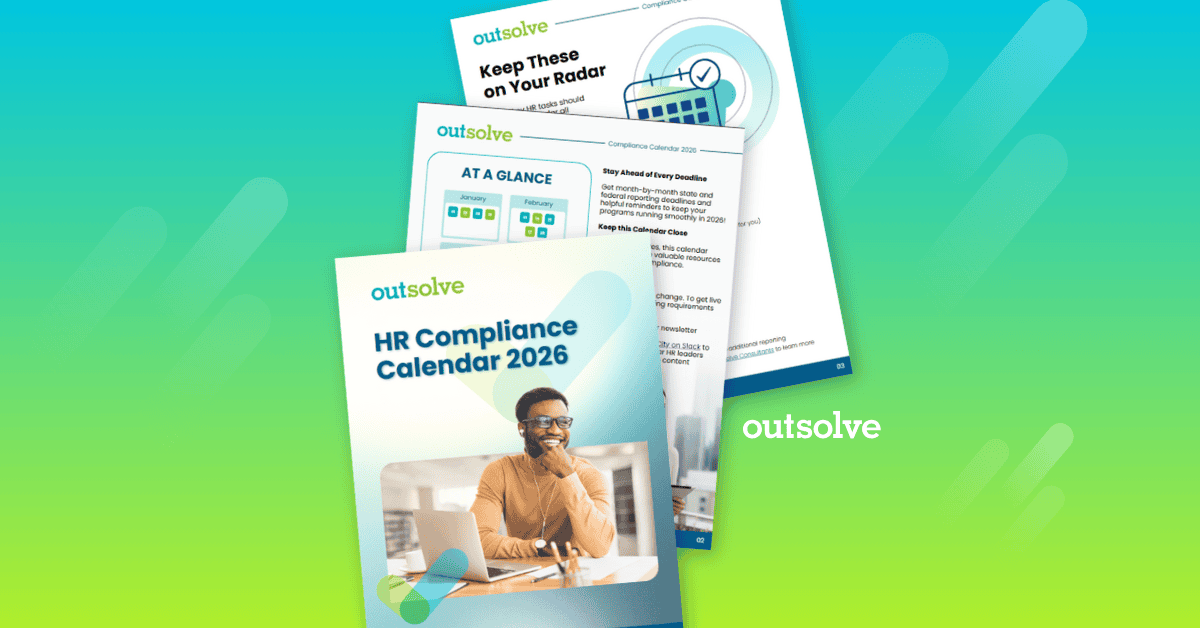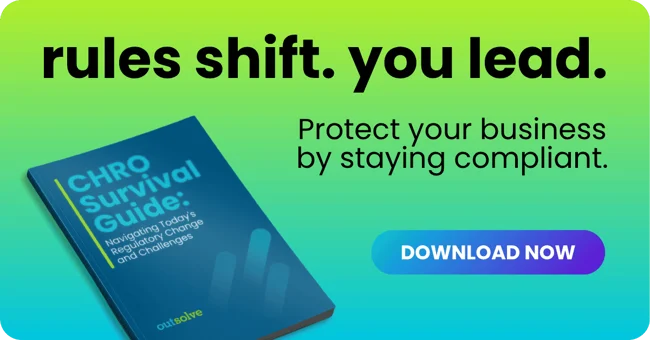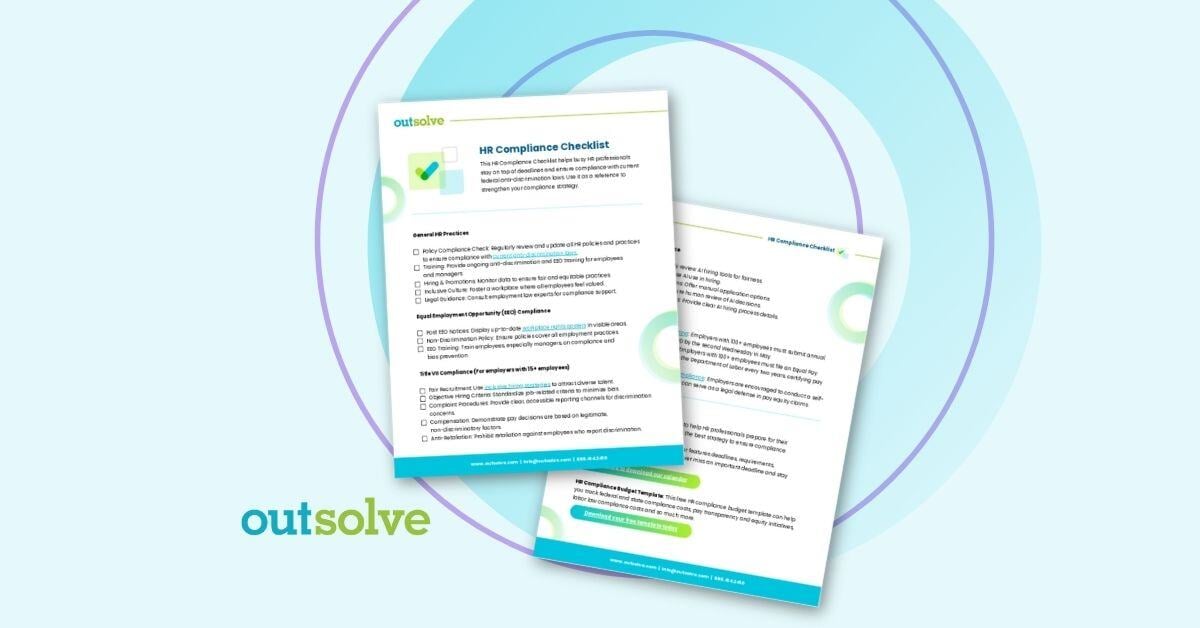7 min read
CHRO Survival Guide: How CHROs Can Navigate the Regulatory Rollercoaster
![]() OutSolve
:
Nov 5, 2025 12:59:57 PM
OutSolve
:
Nov 5, 2025 12:59:57 PM

Welcome to the first of our 3-part research series titled CHRO Survival Guide: Navigating Today's Regulatory Change and Challenges. This part dives into the wave of Executive Orders issued in 2025 that are reshaping workplace compliance. We explore how sudden regulatory shifts create uncertainty, the cultural and legal risks they pose, and what actions CHROs can take to stay aligned with organizational values.
If the role of Chief Human Resources Officer (CHRO) wasn’t already complex enough, recent events and technical innovations have taken it to a new level. Today’s HR leaders and their teams are working in a ‘new normal’ that feels more unpredictable than ever. This paper looks at some of the biggest challenges they face now, including:
- Whiplash from Washington - Regulatory changes prompted by broad Executive Orders (EOs) that unwind decades of accepted practice coupled with long lag times between policy announcements and guidance on how to comply.
- The Hidden Costs of Deregulation – The implied goal of deregulation is to free businesses and other organizations from unnecessary requirements. But without clear guidance from regulators, the administrative burden of anticipating what to change and developing alternative scenarios for compliance can be significant.
- Managing Data Requirements and Implications of AI – Today’s CHROs must meet the incessant demand for more data. Much of it is useful for internal planning and management. Some is required for regulatory compliance. Artificial Intelligence in HR systems can help ease the workload. But if not implemented properly, it could expose the organization to unintentional bias and data privacy concerns.
- Talent Acquisition & Retention Across Generations – There is a well-recognized and growing imbalance between open roles and qualified applicants. HR professionals must now seek new ways to attract new talent that is increasingly hard to find and spread across four generations.
- Reconciling Corporate Culture with Regulatory Policy – If new regulations restrict certain hiring and workplace equity practices already ingrained in the organization’s culture, CHROs must find legally compliant ways to preserve them.
Now more than ever, CHROs must navigate serious crosscurrents without losing sight of what their organization stands for and what makes it successful in the first place. This requires paying close attention to regulatory policy shifts to determine how, and how fast, to react. It’s also a good idea to acknowledge just how complex the job has become. This paper is intended to bring some of this complexity into sharper focus so it can be managed more successfully.
Whiplash from Washington — Managing the Impacts of Deregulatory Policy
The volume of Executive Orders (EOs) produced in the first seven months of the Trump administration is unprecedented. More than 180 EO were issued between January and August of 2025. (Compare this to a total of 162 EOs by the Biden administration over the entire 4-year term.)

Some of these early-term EOs are specifically designed to repeal long-standing federal requirements for workplace policies and practices. The unwinding of decades-old regulations is not as simple as tearing up the rulebook. In practice, it often requires more effort to undo a policy than it took to implement it in the first place.
Most compliance practices and reporting frameworks are specifically designed to meet regulatory requirements. This can make them deeply embedded in an organization’s processes. When those rules change suddenly, CHROs face a dual challenge: modifying existing practices while ensuring the new approach is both legal and operationally sound.
Executive Orders with Immediate Impact
How EO 14173 Reshaped Government Contractor Obligations
Among the orders issued in the first half of 2025, none has more significant impact on HR policies and practices in federal government contractor workplaces than Executive Order 14173: Ending Illegal Discrimination and Restoring Merit-Based Opportunity.
This Executive Order revoked requirements for federal contractors and subcontractors to maintain affirmative action plans for women and minorities. It directed the Office of Federal Contract Compliance Programs (OFCCP) to cease enforcing Executive Order 11246, which has mandated equal opportunity in government contractor workplaces for the past 60 years.
Following this rescission, the acting Secretary of Labor issued an order holding in abeyance, or temporarily suspended, any audits of equal opportunity obligations for individuals with disabilities and protected veterans. Once the Department of Labor had a confirmed Secretary, it issued an order ending all OFCCP compliance audits, including the disability and veteran components previously held in abeyance.
EO 14173 Repositions DEI as a Legal and Cultural Risk
The language of EO 14173 is forceful. It frames certain Diversity, Equity, Inclusion, and Accessibility (DEIA) policies as “…dangerous, demeaning, and immoral race and sex-based preferences.” It further asserts that these polices may violate federal civil rights laws and undermine merit-based opportunity.
In addition, it also revokes several previous executive actions related to diversity and equal employment, including Executive Orders:
- 11246: Equal Employment Opportunity, 1965
- 12898: Environmental Justice in Minority Populations, 1994
- 13583: Promote Diversity and Inclusion in Federal Workforce, 2011
- 13672: Amendments to E.O. 11478 regarding gender identity protections, 2014

What's Still Required and What Isn't
Many HR teams may be confused after the (purported) revocation of EO 11246. Headlines like “Trump Deals Death Blow to DEI and Affirmative Action” from the Washington Post certainly make it seem like OFCCP requirements are gone. But in reality, only the race/sex obligations tied to EO 11246 are gone.
On July 2, 2025, the Secretary of Labor authorized OFCCP to resume processing complaints alleging discrimination based on protected veteran or disability status.
| Status | AAP Plan | What's Still Required? |
|
|
Section 503 of the Rehabilitation Act |
|
|
|
Vietnam Era Veterans Readjustment |
|
|
|
EO 11246 Requirements |
|
A New Compliance Minefield: False Claims Act Risks in DEI Practices
There is another, rather insidious, risk associated with EO 14173 that relates to potentially running afoul of the False Claims Act (FCA) when it comes to the DEI certification requirement of the EO. As described above, EO 14173 revoked the race and sex affirmative action requirements of EO 11246. It also directed federal agencies and the DOJ to police illegal DEI “preferences.”
The DOJ followed this EO with a memorandum instructing the Civil Rights Division to investigate illegal DEI/DEIA practices, and in May 2025, the DOJ formed a Civil Rights Fraud Initiative Unit to pursue FCA matters involving unlawful DEI. A recent analysis by Reuters explains that “… [14173] directive suggests that if a federal contractor maintains DEI policies found to include race or gender-based preferences, they could be found in violation of federal law and subject to penalties under the FCA.”
Given the whirlwind of regulatory pronouncements and contradictory messaging, it is no wonder organizations do not know which requirements still apply, which are no longer required, and which are not allowed at all.
EO 14173 Complications
While the administration’s stated intent was to remove what it calls ‘burdensome diversity mandates’, this EO has introduced significant uncertainty for employers. The absence of detailed compliance instructions from OFCCP has left companies unsure whether past diversity programs might now be legally problematic. Some legal experts caution that even voluntary DEI programs could be challenged under the new interpretation if they are seen as giving preferential treatment based on race or sex.
The Case for Preserving the Internet Applicant Definition
“In some instances, the regulatory framework being eliminated was helpful to employers, and it is perhaps not entirely wise to eviscerate it completely from processes and policies,” advises human resources compliance attorney Alissa Horvitz.
“For example, take the definition of an ‘Internet Applicant.’ The OFCCP has defined an Internet Applicant and allowed employers to exclude from equal opportunity barrier analyses applicants who were not actually considered for a particular open position, were not qualified for the position, or who withdrew interest prior to receiving an offer.”
In using data to conduct future barrier analyses, even though EO 11246 has been rescinded, it still seems prudent to exclude some applicants. For example: those who applied too late; were never looked at for the job opportunity because the employer had too many applicants to review them all; didn’t have the minimum qualifications for the job; were unresponsive to emails and texts or notified the employer prior to getting an offer that the applicant found work elsewhere.
Horvitz adds, “Even though the OFCCP is moving to rescind the regulations that included the Internet Applicant definition, it still seems worthwhile to retain dispositions that track the Internet Applicant definition in the tracking system.”
The Legal Vetting Bottleneck
Along with the pure volume of these federal policy changes comes an additional challenge: the time lag between an EO’s issuance and the publication of compliance guidance from agencies like OFCCP, the EEOC, or the Department of Labor. Government Executive reports that organizations can expect to wait months before binding instructions are provided.
For example, the Office of Information and Regulatory Affairs (OIRA) received an Interim Final Rule implementing EO 14173 on April 15, 2025. As an interim final rule, the administration is not affording employers notice and the opportunity to comment. This leaves CHROs unable to forecast and plan. As of September 2025, no rule has been finalized or published. This creates a gray zone in which neither inaction nor proactive policy change feels safe. The risk isn’t just non-compliance. It is also the potential reputational damage if an organization is perceived as dragging its feet or moving too aggressively to undo practices that employees support.
The challenge isn't just figuring out what to stop doing – it's understanding what's still required, what's now prohibited, and what falls into a gray area. According to a report by ComplianceHR, organizations expect to spend much more time on internal compliance reviews and legal vetting of their programs than in years past.
Cultural Consequences
Even when legal interpretations shift, employee expectations often remain unchanged. Workers who value and expect DEI may see any rollback as a values statement, regardless of intent. Business Insider reports that in some organizations, internal communication teams have had to devote significant time to “values reaffirmation” campaigns to keep morale steady.
Companies like Salesforce and Google have already faced employee petitions over policy shifts that were perceived as misaligned with stated values. And as observed by Ms. Horvitz’ practice, “Some organizations are facing competing shareholder initiatives asking for the cost of eliminating as well as retaining DEI programs.”
Actions for CHROs and / Leaders
- Audit existing DEI initiatives for unlawfulness and to identify which practices can/should be continued, altered, renamed or discontinued.
- Identify policies, reporting process, and training modules linked to rescinded regulations – such as training courses, interview questions/data collected, statistical reports, etc. – to assess whether modifications are legally necessary or culturally advisable.
- Request written legal interpretations from counsel before dismantling long-standing programs.
- Maintain desirable, or possibly legally required, diversity initiatives. Frame them in business terms (e.g.: community engagement) rather than as regulatory mandates, where possible.
- Communicate early and often with employees about the company’s cultural commitments, clarifying what will and won’t change.
- Scenario-plan for activism. Anticipate how different employee groups might respond and prepare leadership talking points in advance.
- Exercise additional caution with attestations to prevent inadvertent FCA violation.
Conclusion
The pace and scope of regulatory change in 2025 have left many organizations struggling to determine which requirements remain, and which could expose them to new risks. For CHROs, the challenge is preserving employee trust and organizational culture while responding to shifting federal directives.
In the upcoming Part 2, we’ll shift focus to the hidden costs of deregulation — exploring why rolling back requirements often creates more complexity for HR teams, how enforcement priorities like Form I-9 and E-Verify are reshaping compliance workloads, and what new demands around pay equity and data management mean for today’s leaders.
Related Resources
- CHRO Survival Guide: How CHROs Can Navigate the Regulatory Rollercoaster
- CHRO Survival Guide: The Hidden Costs of Deregulation and the Rise of AI in HR Compliance
OutSolve commissioned this research report to educate and inform employers and clients of dramatic change in the human resources landscape. By analyzing the latest regulatory shifts, emerging compliance risks, and technological disruptions facing HR leaders, this report provides actionable insights and practical strategies tailored for both federal contractors and private sector organizations. Our goal is to equip HR teams with the knowledge they need to navigate new challenges, remain compliant, and sustain high-performing, values-driven workplaces in the face of today’s uncertainty.
Founded in 1998, OutSolve has evolved into a premier compliance-driven HR advisory firm, leveraging deep expertise to simplify complex regulatory landscapes for businesses of all sizes. With a comprehensive suite of solutions encompassing HR compliance, workforce analytics, and risk mitigation consulting, OutSolve empowers organizations to navigate the intricate world of employment regulations with confidence.
Weekly OutLook
Featured Posts

New Year, New Deadlines: 2026 HR Compliance Calendar

outRageous HR: Plan Now or Pay Later
Related Posts

Refreshing Your I-9 Tools and Process to Stay Compliant
Form I-9 is a federal requirement that carries real consequences if handled improperly. With increased scrutiny on immigration by the current...
.png)
New Year, New Risk: Why Federal Contractors Can’t Hit Snooze
Lean in to disciplined, data‑driven compliance

An HR Year in Review: Key Updates in 2025
The unpredictability of 2025 has been an uphill trek for HR teams across the U.S. This year brought substantive employment compliance changes to...


